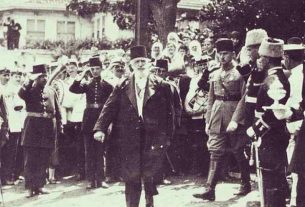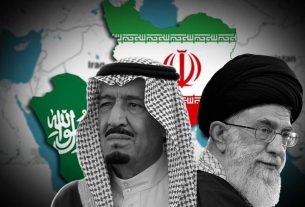Fri 21 February 2020:
Driven by geopolitics and economics, both Gulf states are courting a close relationship with Modi’s India.
India over the last month has faced protests against the Modi government’s Citizenship Amendment Act (CAA) and the eventuality of a National Population Register (NPR), which critics have said is discriminatory against Muslims and is “un-secular” in intent. That begs the question of why the Islamic countries in the Middle East have remained quiet about the ongoing upheavals in the world’s most populous democracy, home to the third-largest Muslim population. The answer lies in more than a decade of rapprochement, realignment, and new geopolitical and economic realities forcing a change of play in the major Arab capitals, along with New Delhi.
In 2004, in the coastal southern Indian state of Goa, known for its sandy beaches and eclectic resorts, leaders of the oil and gas world met to formulate new strategies and bridges during a time when the fear that “oil is running out” was taking precedence. This was when former U.S. Secretary of State Rex Tillerson, then the executive vice president of American hydrocarbons giant ExxonMobil, made his first trip to India. Also in attendance was Abdullah S Jum’ah, then the CEO of Saudi Aramco, arguably the world’s richest company. At the time, Jum’ah strengthened an important strategic fault line for New Delhi by saying that Riyadh will stand by the country’s energy security needs, strong backing for a nation of 1.3 billion people reliant on oil and gas imports from the Middle East to propel its freshly bulging economy.
This early 2000s was precisely when a shift in the thinking of Riyadh and Abu Dhabi was starting to become visible, in alignment with the much-celebrated rise of the Indian economy as the major growth story in Asia, along with China. In 2003, then-President of India A.P.J. Abdul Kalam’s visit to the UAE was to become a foundational trip on which modern economic ties between the Gulf and India were to be built. In January 2006, the visit of late King Abdullah bin Abdulaziz Al Saud to New Delhi as the chief guest for the country’s Republic Day heralded a new era in Saudi-India relations. Led by Indian Prime Minister Manmohan Singh, the two countries signed the “Delhi Declaration,” which installed itself as the rudder for a renewed economic, security, and political partnership. This was followed by a visit to Riyadh by Singh in 2010 and the signing of a reciprocal “Riyadh Declaration.”
Both these declarations re-directed Saudi-India ties significantly away from the status quos of the 1990s, where India’s relations with the Gulf were less than ideal and mostly based around migrant workers, oil transactions, and remittances critical to the Indian economy. However, post-2004, the situation had changed significantly. For the Gulf, India became a large economy in need of increasing oil while supplies to the West were expected to decline. This meant the likes of Riyadh and its ally and neighbor UAE had to not only re-draw their approach to New Delhi, but also by association recalibrate their influence toward Pakistan, where Riyadh exerted strong control over polity, religious institutions, and military.
To put the above in perspective, in the 1990s it would have been almost inconceivable that either Saudi Arabi or the UAE would deport terror suspects wanted by New Delhi. However, over the past few years, India has managed to repatriate wanted Indian citizens from both Saudi Arabia and the UAE, including those wanted for pro-Islamic State activities, highlighting a new opening of strategic ties between New Delhi and the Gulf region. In August 2015, the Indian Air Force made its first staging visit to Saudi Arabia, while India and the UAE had their first bilateral naval exercise in March 2018. The first joint naval exercise between New Delhi and Riyadh is slated to take place in March this year.
The fact that India’s bonhomie with the UAE and Saudi Arabia accelerated significantly under the Modi government has raised some eyebrows. It’s surprising to many that a government led by a Hindu-nationalist party, the BJP, managed to drive the India-Gulf dynamic at great speeds despite facing criticism over alleged anti-minority policies and anti-Muslim cases of lynching and violence in certain states of the country. The answers to this are as complex as the question itself, and are rooted in a realistic and narrow approach to foreign policy, limitations of interests in bilateral relations, and the conception of domestic and regional security by both sides.
With the UAE well into being a major center for global finance and business, Saudi Arabia’s crown prince and heir apparent Mohammed bin Salman (MBS) is determined to follow the footsteps of Abu Dhabi’s Mohammed bin Zayed Al Nahyan (MBZ) in making Saudi Arabia’s economic future less reliant on its current addiction to petro-dollars and more based on business, manufacturing, services, and so on. Large market economies looking for investments and offering returns in relatively peaceful political climates are far and few between, and developing nations such as India (along with China) not only have large appetites for oil, but also thirst for foreign investments to stimulate growth. In fact, according to the International Energy Agency (IEA), India is slated to overtake even China in oil demand by the middle of this new decade.
Modi’s first term in power beginning 2014 had kept the country’s economic development at the forefront of the political agenda. Winning the elections and forming a government with a majority, not shackled by coalition politics, provided a more palatable structure for the Gulf monarchies to deal with. Modi made visits to Saudi Arabia and the UAE and, despite keeping it comparatively low-key, welcomed MBS to New Delhi during the thick of the Jamal Khashoggi murder crisis. In return, Modi got to inaugurate the first Hindu temple in the UAE in 2018, and was conferred with the highest civilian honor by both Abu Dhabi and Riyadh. This marked a big step since 2014, when both the UAE and Saudi Arabia were more than careful in welcoming him as the new leader considering his history as the former chief minister of Gujarat during the Godhra communal riots in the state in 2002, after which the United State had installed a visa ban on the then-regional leader.
However, it is pertinent to note that even during the 2002 riots, neither the Gulf capitals, nor their ambassadors in New Delhi had, per accounts, asked for a briefing from the then-Indian government, which was also led by the BJP under the leadership of late Prime Minister Atal Bihari Vajpayee. Previous instances of communal disruptions in India, including the demolition of the Babri mosque in the state of Uttar Pradesh in 1992, had created a much larger uproar in the Gulf region, despite the lack of internet, social media, and modern communications at that time. However, in recent cases, more direct contact with Riyadh and Abu Dhabi was established around decisions such as the abrogation of the state of Jammu and Kashmir in August last year, with National Security Adviser Ajit Doval visiting Riyadh and meeting MBS to put forward the details of India’s move on Kashmir, which was positively received.
Amid this back and forth and development of relations with New Delhi, one of the achievements from India’s perspective has been gaining significant space for messaging against Pakistan’s access to the Gulf Cooperation Council (GCC) and the Organization of Islamic Cooperation (OIC), allowing India to successfully abrogate Islamabad’s views on Kashmir within the Islamic world. The fact that former Indian Minister of External Affairs Sushma Swaraj was invited to the OIC to deliver a talk in March last year despite string opposition by Pakistan, which had thwarted India’s attempt to join the forum in 1969, is particularly notable. This outreach to India over the past few years has affected Pakistan’s exclusivity in the region as well, as witnessed recently when Prime Minister Imran Khan attempted to attend the Kuala Lumpur Islamic summit organized by Malaysian leader Mahathir bin Mohamad, along with Iran, Qatar, and Turkey. Khan later cancelled his visit after Riyadh stepped in, which had opposed the summit from the beginning. In return, as per reports, Pakistan may reportedly gain a meeting on Kashmir in the OIC, and a $200 million push by MBZ for its flailing economy.
India’s diplomacy in the wider Middle East region is marked by rich diplomatic ties with the three poles of power, Riyadh, Jerusalem, and Tehran alike, without burning its hands in the region’s internal quagmire. Till now, New Delhi’s diplomacy with the Gulf has not breached its equally consistent outreach with the others. The inaugural Air India flight connecting New Delhi to Tel Aviv in 2018 being allowed to use Saudi airspace illustrated India’s advertised concept of “strategic-autonomy” at play. However, MBS and MBZ’s outreach to Modi and vice-versa has seen the most success from New Delhi’s institutional outreach over the years. While the economic front remains the most important arena here, the coming year may be critical to show whether it actually materializes into concrete investments for both regions or not.
Kabir Taneja is a Fellow, and head of the West Asia initiative with the Strategic Studies Programme, Observer Research Foundation, New Delhi. He is the author of ‘The ISIS Peril: The World’s Most Feared Terror Group and its Shadow on South Asia’.
-Article Originally Published in thediplomat
The statements, views and opinions expressed in this column are solely those of the author and do not necessarily represent those of Independent Press.
Think your friends would be interested? Share this story!





